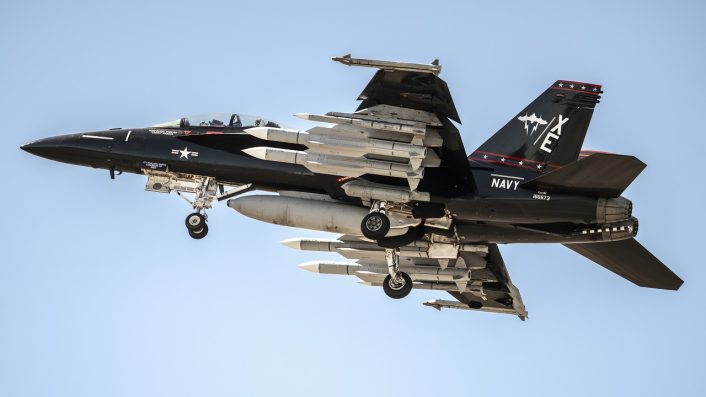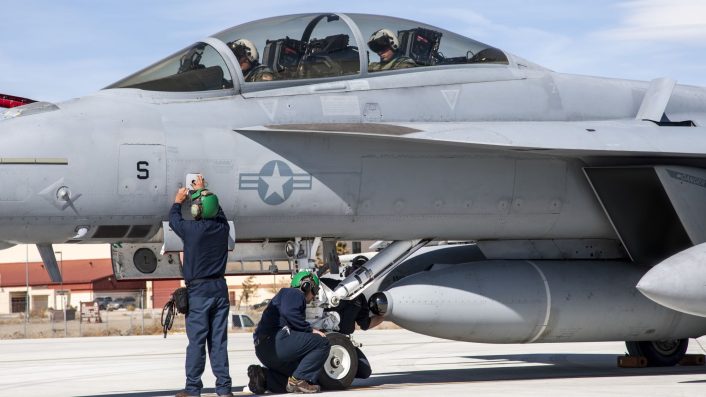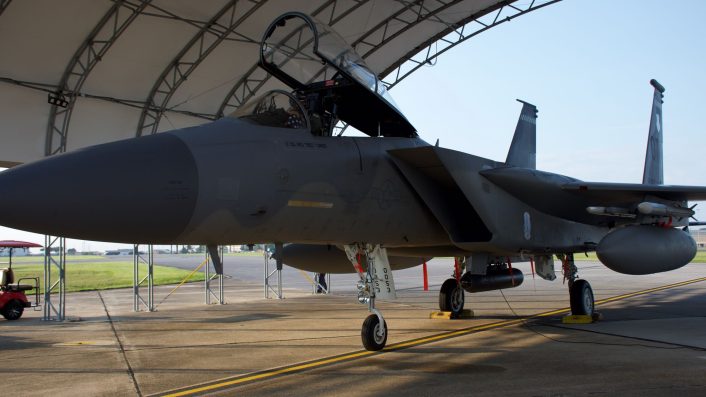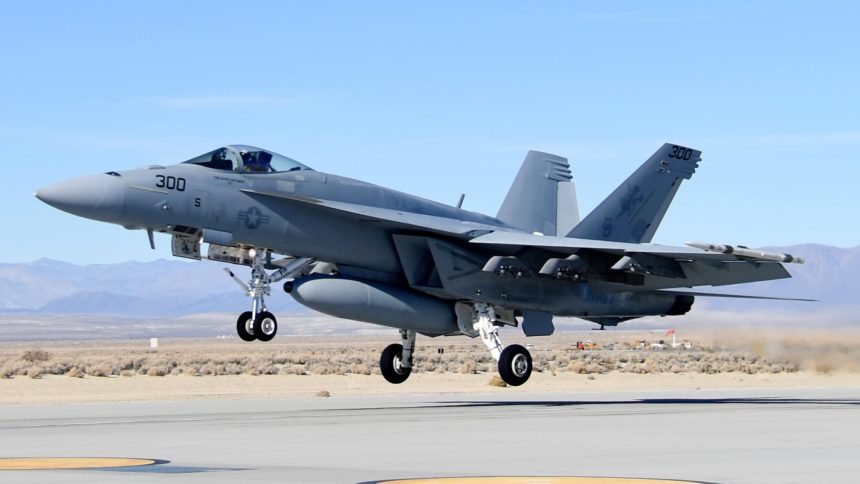The IRST Block II enhances ‘situational awareness by supplementing air-to-air detection and track capabilities, and autonomously or in combination with other sensors, supports the guidance of beyond visual range missiles.’
The U.S. Navy declared the initial operational capability (IOC) of the IRST (Infrared Search and Track) Block II for its F/A-18E/F Super Hornet fighters in Nov. 2024, NAVAIR (Naval Air Systems) command announced on Feb. 4, 2025. Offering “enhanced capability to search, detect and track airborne targets at long range,” the IOC of the long-awaited IRST system marks an “important milestone in our overarching efforts to deliver advanced integrated warfighting capability to the fleet,” said Rear Adm. John Lemmon, Program Executive Officer for Tactical Aircraft Programs.
The IRST Block II
Designated as the ASG-34A(V)1, the system has as its primary contractors Lockheed Martin’s Missiles and Fire Control division and Boeing Defense. The system is part of a double use pod, with the IRST Block II sensor, also known as IRST21, housed in the front of the FPU-13/A fuel tank that is carried on the jet’s centerline.
The FPU-13/A external fuel tank is a redesigned FPU-12/A, with its fuel capacity reduced from 480 gallons to 340 gallons to make space for the sensor and its electronics. The IRST Block II’s operationalization has been delayed by almost two years, according to timelines noted in the DOT&E (Director of Operational Testing and Evaluation) report.
As NAVAIR mentioned, a decision for full-rate production will be taken in spring 2025 to allow the U.S. Navy to procure the IRST Block II for all its F/A-18E/F Super Hornet squadrons. The project was led by the F/A-18 and EA-18G Program Office (PMA-265), which is responsible for the F/A-18A-D Hornet, F/A-18E/F Super Hornet and EA-18G Growler aircraft.
It is not clear if the external IRST is also meant for the U.S. Marine Corps’ older F/A-18C/D Hornets. Abroad, Australia ordered 12 IRST Block II pods for the Royal Australian Air Force’s fleet of 24 F/A-18F Super Hornets in Aug. 2024, according to the Australian Defence Magazine. The $74 million deal will see pods delivered throughout 2025.
A first for #F18! At the end of 2019, the jet flew with an Infrared Search & Track (IRST) Block II pod, which will improve situational awareness for pilots of the @USNavy‘s Block III #SuperHornet aircraft.
RELEASE: https://t.co/250dNU9KEu pic.twitter.com/j5A9inabqA
— Boeing Defense (@BoeingDefense) January 15, 2020
IRSTs are usually placed ahead of the cockpit and co-located with the primary radar in the nose of the aircraft, as they are generally developed to complement it as a passive detection capability. Except for the F-35 family, no U.S. frontline multirole strike fighter currently in service has an integrated IRST capability, but have either fielded it and tested in other podded platforms. These are external systems like the Sniper pod that doubles up as an IRST, or dedicated anti-aircraft IRST like the Legion pod, which uses the same IRST21 sensor now integrated on the Super Hornet.
Development and integration effort
According to NAVAIR, the system achieved IOC after “completing Initial Operational Test and Evaluation with Air Test and Evaluation Squadron (VX) 9.” Interestingly, the VX-9 “Vampires” squadron is also the same unit whose F/A-18F Super Hornet was spotted with a heavy air-to-air loadout of four AIM-174Bs, the air-launched version of the Standard Missile-6 (SM-6), beside three AIM-120s and two AIM-9Xs, in Sep. 2024.
In that occasion, the Super Hornet was also carrying the new IRST pod on the centerline, with the dark IRST21 sensor protruding in the front. The presence of the IRST was not casual, as it is intended to act as a complementary sensor to the AN/APG-79 fire control radar in a heavy electronic attack or radar-denied environment and allow the employment of the air-to-air weapons.
PMA-265 collaborated with military, civilian contractors and personnel from other operational test and evaluation squadrons, VX-31 and VX-23. According to NAVAIR, PMA-265 was able to “leverage a novel combination of operational and developmental test facilities and assets throughout the past year.”

The Navy introduced IRST to the fleet in two phases, beginning in 2011 when Block I integrated an existing IRST system onto the F/A-18 fuel tank. Then in 2019, “the fleet operated the system as a part of an early deployment.” With the second phase, “Block II added an improved sensor, upgraded processor and additional software with a first deployment planned in 2025.”
Boeing announced on Jan. 15, 2020 that an F/A-18 Super Hornet equipped with an IRST Block II pod flew for the first time in late-2019. The reason for the IOC being achieved five years after the first flight are the reliability failures of the IRST Block II which adversely affected the operational testing.
The DOT&E report specified that the Navy conducted the operational testing with a specific variant of the pod, called the Infrared Optimized Configuration (IROC) pods, described as an operationally equivalent pod designated for flight test. The report, however, clarified that the IROC pods will not be released to the fleet as they are intended to be used for testing only.
It was also stated that Low-Rate Initial Production (LRIP) pods with a possibly increased reliability were expected to be first delivered in September 2024. These pods would reach carrier-based Super Hornet squadrons during the first quarter of 2025 to “improve lethality and survivability in air superiority missions against advanced threats.”
According to the report, “IRST Block II operational flight test events demonstrated tactically relevant detection ranges against operationally relevant targets and the ability to translate these long-range target detections into stable system tracks to facilitate weapons employment.” However, it appears there are still some integration problems as the report further adds that “The Navy must continue to improve the F/A-18 E/F Super Hornet’s operating software and address existing deficiencies to effectively integrate IRST into aircraft fire control solutions.”
Regarding reliability problems, which are described as significant, the report mentions that the “IRST Block II suffered from hardware and software deficiencies, which required the aircrew to restart the pod multiple times.” While these deficiencies will only be described in the classified DOT&E report, the unclassified one explained that “Troubleshooting and repair often exceeded the abilities of Navy maintenance crews and required assistance from Lockheed Martin.”

Tactical use
RAdm John Lemmon explained that “IRST provides data for our aircrew to improve reaction time and survivability while remaining unaffected by radio frequency jamming.” The press release further explained that the IRST “increases situational awareness by supplementing air-to-air detection and track capabilities, and autonomously or in combination with other sensors, supports the guidance of beyond visual range missiles.”
As mentioned earlier, in the F/A-18’s case, the IRST complements the AN/APG-79 fire control radar in a heavy electronic attack or radar-denied environment. Operating in the long-wave infrared range, it can function autonomously, or in combination with other sensors, to support the guidance of the AIM-120 AMRAAM (Advanced Medium-Range Air-to-Air Missile) and the AIM-9X Sidewinder Block II missiles.
However, the IRST Block II reduces the capacity of the new FPU-13/A’s fuel tank, on which it is installed, to 340 gallons, compared to the 480 gallons of fuel carried by the original FPU-12/A. The tradeoff in the fuel capacity was deemed justified by the introduction of the new important capability, although the FPU-13/A might have also lost the capability to be jettisoned, since it now hosts a sensor.
An IRST fused with a powerful AESA radar provides an important increase in the options available to pilots. In fact, a first function would be to provide additional information about a target’s infrared profile to enhance target discrimination even without a targeting pod.
Other options are strictly related to the IR technology, the first being the already mentioned capability to search and track targets in a radar-denied environment. However, another important capability is the passive detection capability of the IR sensor which, compared to the radar, doesn’t alert the self-defense systems of an adversary aircraft, while also lowering the electromagnetic emissions of the aircraft if the pilot switches off the radar entirely.

IRST on other U.S. military aircraft
Except for the F-35 Lighting II series, all frontline U.S. military multirole/strike platforms, including the most advanced F-15EX variant, the F-16 series, the F-22 and the F/A-18 series, do not have an organic IRST capability. These aircraft mainly use their targeting pods, when equipped, to replicate some of the capabilities of an IRST system.
However, IRSTs were separately tested in podded forms. For instance, on Aug. 5, 2021, an F-15C from the 85th Test and Evaluation Squadron (85th TES) carried a Lockheed Martin Legion Pod IRST which was used to cue and launch for the first time an AIM-120 AMRAAM without using the radar.
Prior to that, on Jul. 13, 2020, an F-16 from the 85th TES took its first ever flight with the Legion Pod. Just a few days before, on Jul. 8, 2020, an F-15C launched an AIM-9X Sidewinder using the Legion Pod. On the F-15 the pod is attached on the centerline, while on the F-16 it is carried on the right chin station beside the air inlet.
Meanwhile, Lockheed Martin announced on Jan. 22, 2025, that the F-22 will receive a next-generation Infrared Defensive System (IRDS) called TacIRST as part of a $270 million contract. Also, the F-22 was already spotted while testing two faceted pods installed under its wings, with budget documents subsequently revealing that an IRST sensor is one of the sensors housed inside the two pods.









